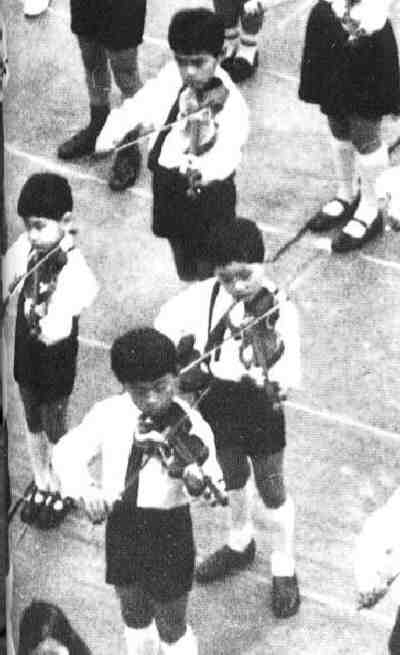
Figure 1.--Famed Japanese instructor is noted for teaching small children to olay the violin. The boys for their recitals normally wore white shirts, ties, blue short pants, and white kneesocks. |

|
We have begun to build a glossary of boys' clothing terms. As boys clothes until the 19th century was the sane as adult male clothing, we have included many applicable men's clothing terms. We have also included some women's terms as younger boys commonly wore dresses until the 20th century. As HBC is extensively used by non-native English speakers we plan to give considerable attention to this glossary so that words can be looked up. It will also serve as an index as we will provide links to the appropriate pages. We eventually hope to add foreign words, but that will take some time.
VanDyke Collar: A VanDyke collar varies in size, some but not all are quite large. There were mostly done in linnen and lace. The shape varied some were relatively small, just around the collar and with a only two points (tips). Some were very large, covering most of the collar. Some were entirely lace. Other were linnen trimmed with lace or reticella. These large collars might have multipile points or rounded extensions. They were popular in European courts during the 17th century. In England the style contrasted with the austere style of the Puritans and became associated with the Caviliers that supported the Stuarts during the Civil War. The name derives from the noted artist Anthony Van Dyck who painted the Stuart kings and their court who commonly wore the fancy collars. It was not a child's style, but a male style associated with the aristocracy. We are not sure what they were called at the time. The name suggests it was an English style. The French court was more important in setting styles, but did not have such an ilustrous artist painting them. Gainsborough's famed Blue Boy portrait had a VanDyke collar, but this is because he outfitted the boy in a 17th century outfit. The Van Dyke collar was presumably the inspiration for the late-19th century Fauntleroy collar. The two terms are not identical. Some Fauntleroy collars did use lace like the VanDyke, but even more common for Fauntleroy collars was ruffles.
Velvet: Velvet is generally considered a luxurious fabric made. True velvet is quite expensive and made from silk. The
image of a Fauntleroy suit is generally associated with velvet for boys wear, but velvet suits were worn well before the late 19th Century. Velvet is still considered a luxurious fabric, but now commonly made of synthetic fibers.
Velvet suits: Velvet was originally a luxurious fabric made from silk and was very expensive. Modern immitation velvets are often made from synthetic fibers (acetate, nylon, rayon, and others). The fabric has a thick, soft pile formed by loops of the warp thread, either cut at the end or left uncut. Velvet sometimes has a cotton backing. Velvet was first made in China. The term first appears in European litterature in thr 13th Century. It was used to produce fine garments for wealthy individuals. The colors ranged widely, but included many bright colors like red. Velvet of various colors, usually dark, was commonly used in the late 19th Century to produce better boys' party suits, especially Little Lord Fautntleoy suits. In the 20th Century boys dress suits are sometimes made of velvet, especially Eton suits for small boys. It is particularly popular for boys suits around the Christmas holiday season. Velvet trim was commonly used for trim on the lapels of better coats for small children.
Vests: Vests have been widely worn by men and boys since at least the 18th century. The vest was initially part od a suit. Most suits were worn with vests through the late 19th century. By the early 20th century, suits were vest became less common. By the late 20th century only the most formal suits came with vests. The vest was in he 19th century mostly worn with the suit jacket. A new fashion for boys of wearing the vest without the jacket developed in the 1950s. This was primarily a winter fashion. Interestingly in the late 20th century, the vest worn without a suit became a kind of dressy summer fashion.
Violin instrumental instruction: This fine stringed instrument has formed the backbone of the Western orchestra for more than 300 years. The unparalleled artistry, musicality, and old-world heritage of the violin has been a matter of legend. There have been celebrated makers and players. The music has inspired great composers of the baroque, classical, and romantic periods as well as the 20th century. The violin is also one of the most popular instruments for boys to learn. Famed Japanese teacher Dr. Suzuki developed methods for teaching young children. The boys for their recitals normally wore white shirts, ties, blue short pants, and white kneesocks.
Navigate the Historic Boys' Clothing Web Site:
[Return to the Main glossary page]
[Introduction]
[Activities]
[Biographies]
[Chronology]
[Cloth and textiles]
[Garments]
[Countries]
[Photography]
[Topics]
[Bibliographies]
[Contributions]
[FAQs]
[Glossaries]
[Images]
[Links]
[Registration]
[Tools]
[Boys' Clothing Home]
Navigate the Historic Boys' Clothing Web chronological pages:
[Return to the Main chronological page]
[The 1900s]
[The 1910s]
[The 1920s]
[The 1930s]
[The 1940s]
[The 1950s]
[The 1960s]
[The 1970s]
[The 1980s]
[The 1990s]
[The 2000s]
Navigate the Historic Boys' Clothing Web style pages:
[Blazers]
[Jackets]
[Long pants suits]
[Kilts]
[Sailor suits]
[Knickers]
[Eton suits]
[Fauntleroy suits]
[Hair styles]
[Youth groups]
